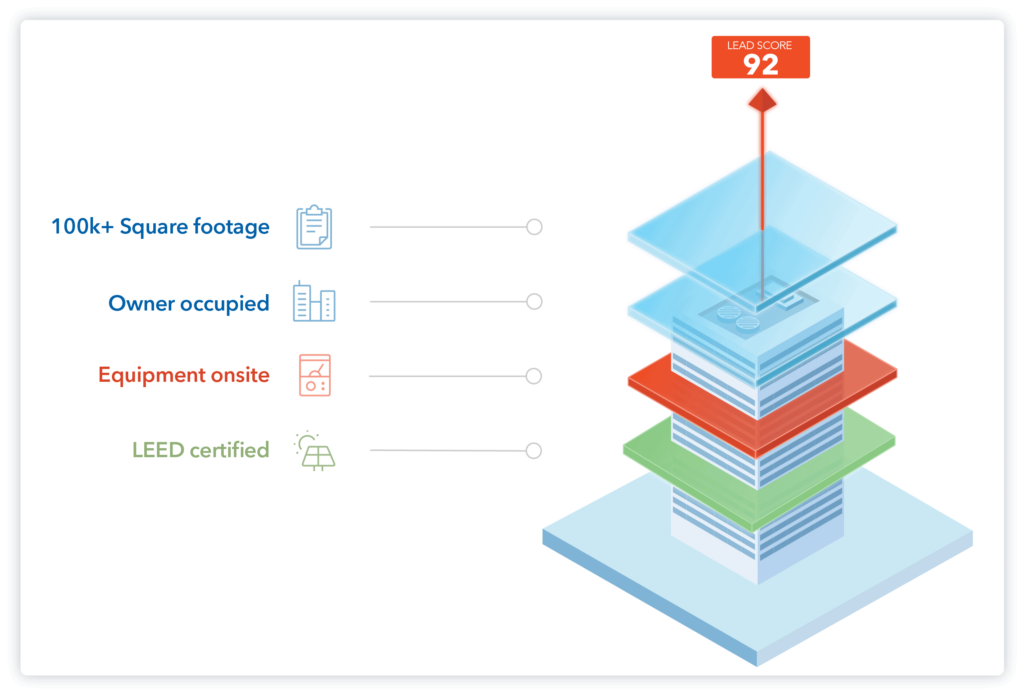Wouldn’t it be great if an impartial third-party expert could come on all your electrical and lighting sales calls and convince prospects how much they need your services? Well, if you’re offering energy-efficient services, you can get pretty close by using energy efficiency scores.
Energy efficiency scores are your silver bullet for finding and closing deals. You can use these scores to better prospect and as part of your marketing campaign or sales pitch. Couple them with information on how customers can find financing, and you’ve got a foolproof electrical and lighting outreach strategy.
Where to Find Energy Efficiency Scores
An energy efficiency score is a standardized way to measure how well a building manages energy usage. There are several different scoring systems out there, and each one has a unique use case for sales.
Building Energy Asset Score Tool
The Building Energy Asset Score tool comes from the U.S. Department of Energy (DOE). It looks at the physical characteristics of a building and its energy systems to calculate an efficiency score, with 10 being the highest score possible.
To use this tool, you’ll need to have a specific building in mind along with access to the building’s particular characteristics, such as:
Its orientation, number of floors, dimensions, and use
Current number and type of light fixtures
Number of windows and skylights the building has and how shaded it is
Type of roof, wall, and floors used in the building and its current insulation
Building operations, such as miscellaneous electric load
Type of heating and cooling system used
Details about the water heating equipment
This tool asks for quite a bit of information upfront before it will generate an accurate score, so it might make sense to use it after you’ve already spoken with someone at your lead’s company willing to offer up these details. You can also use this score for existing customers you want to upsell on more efficient lighting options.
ENERGY STAR Score
The ENERGY STAR score shows how well a building measures up against similar structures across the United States. It’s on a 1-to-100 scale, and a building will need to score 75 or higher to receive an ENERGY STAR certification. Building owners have to apply for certification, and there are almost 38,000 commercial buildings in the country that have earned one.
ENERGY STAR maintains a searchable database of all of the properties that have earned certification. You can drill down to results based on location, building type, and even property owner or manager.
This tool will only show you those properties that have earned certification—your search results won’t show inefficient buildings. But that’s still valuable information to have. You can use this tool to eliminate leads that already have an energy-efficient electrical or lighting system (or you can include them in another sales campaign that focuses on upsells or grabbing more market share from competitors).
LEED Certification Score
LEED (Leadership in Energy and Environmental Design) is a global certification program designed to recognize green buildings. Commercial property owners can earn certification by meeting a list of carbon-reducing criteria. LEED certifications follow a tiered point system where a building is deemed:
Certified with 40 to 49 points
Silver with 50 to 59 points
Gold with 60 to 79 points
Platinum with 80 points or more
You can generate a LEED scorecard for each property on your list of leads. Similar to the DOE’s tool, you’ll need pretty detailed information to fill out the full scorecard. And, like ENERGY STAR, LEED offers a searchable database you can use to cut dead ends from your list. Keep in mind that since LEED offers tiers of certification, if one of your leads is already certified, you could pitch your upgrades as their path to reaching Gold or Platinum.
How to Use Energy Scores to Close More Deals
It’s simple: include energy efficiency scores in your lead scoring criteria and use them to back up your marketing campaign or sales pitch.
Start your lead scoring process with the basic criteria of your ideal customer in mind (and if you’re not clear on criteria, it’s time to align sales and marketing on who your prime targets are). Think about what square footage you’re looking to service, the size of a company you need to generate enough revenue, and the vertical each lead is in if you’re specialized to serve a particular niche. Weed out any dead-end leads that don’t meet your criteria.
Next, apply your energy efficiency scores to your lead scoring. Eliminate any prospects that are already certified and look for properties with a LEED score that could be pushed higher with some energy upgrades.
As an important aside: Finding enough information to get really detailed with lead scoring is a tough task to manage manually. The Convex Intelligence Engine helps revenue leaders combine property data, business data, and people data with third-party information (like energy efficiency scores) to make this process much simpler and more accurate.

The Convex Intelligence Engine helps teams target based on data gathered from multiple sources.
Couple your energy efficiency scores with research into each company. Do they have any public sustainability goals (and, if not, do their competitors)? Are they in a vertical where pushing for energy efficiency makes sense (think green-adjacent industries, such as waste management)? Or are they in an energy-intensive one, such as hospitals, where cutting usage by even a small percentage could translate into a huge reduction in costs?
Energy efficiency scores can also support a great pitch. Energy-efficient buildings save money, and data from ENERGY STAR confirms it. Since 1992, the program has saved businesses almost $200 billion in energy costs. Certified buildings are worth more, too—they sell and rent for around 16% higher than other properties. Making energy-efficient changes represents a low-risk investment for your leads.
Those are great selling points, but you can get even more creative here. Calculate the efficiency scores for your current customers and showcase the progress they’ve made since signing on with your company. You can also use those scores to estimate savings for other similar properties—and to provide your marketing team with something compelling to spotlight in their next campaign.
You can also take it a step further by walking your leads through one of these tools in real time. Start by helping them calculate their current score before showing them how high it could jump with the right changes to their systems.
Help Leads Find Funding to Offset Costs
The final piece of the puzzle is taking a high-touch approach to nurturing leads and helping them secure the funds needed to buy. Helping your leads find subsidies, rebates, or financing will go a long way toward addressing any hesitance they’re feeling about the cost of upgrading their system.
There are plenty of options available to help offset those upgrading costs:
The DOE’s Commercial Property Assessed Clean Energy (C-PACE) Program offers upfront financing for energy efficiency upgrades (and take a look at our guide on C-PACE funding).
That list is just the beginning: there are many more funding options available for energy upgrades.
Make Third-Party Data a Core Component of Your Go-to-Market Strategy
Energy efficiency scores can be used in multiple ways. They can point you toward promising prospects, form the backbone of a persuasive sales pitch, and add ammunition to your marketing campaigns (if you tout the wins you’ve earned with other customers).However, leveraging scores in those ways means you need complete, organized data—and you can find out how to get that by scheduling a conversation with a Convex expert today.
Share





